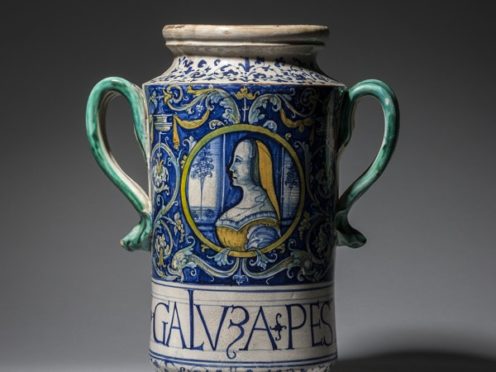The British Museum has reunited a rare Italian jar, designed to store medicinal ointments and drugs, with its sister piece.
The tin-glazed earthenware object, called an albarello, dates from the 16th century and features the image of a woman surrounded by masks, garlands and scrollwork.
It is thought to have been made between 1510 and 1530 in Siena for the Monastery of Santa Chiara in the nearby town of Massa Marittima, Tuscany, and was probably used to store powdered oak galls.
The jar and its sister piece were originally part of a larger set of pharmacy jars, of which only 12 survive.
The albarello was donated to the British Museum through the Cultural Gifts Scheme, in honour of Dr Dora Thornton, former curator of Renaissance Europe and the Waddesdon Bequest.
The donor company’s director Sam Fogg said: “I am very pleased to have been able, through the Cultural Gifts scheme, to present this outstanding maiolica albarello to the British Museum, in honour of Dora Thornton and in tribute to her scholarship and her ability to communicate her knowledge to both specialist and wider audiences.
“Especially notable in the context of this gift is Dora’s remarkable catalogue, co-authored with Timothy Wilson, of the British Museum’s world-class maiolica collections, which has become an essential resource for all of us who love and study these beautiful ceramics.”

Chairman of the acceptance in lieu panel Edward Harley said: “I am delighted that this beautiful albarello has been given, through the Cultural Gifts Scheme, to the British Museum to honour Dora Thornton.
“I hope that such generosity will encourage others to use the Cultural Gifts Scheme to donate objects to the UK’s public collections.”
Arts minister Caroline Dinenage said: “Thanks to the Cultural Gift Scheme, this outstanding object will find a fitting new home at the British Museum, where it will be enjoyed by millions each year and honour the work of a former curator.”
